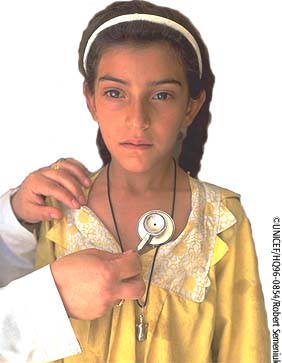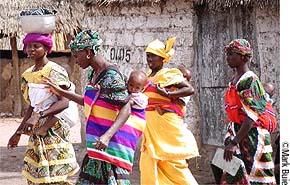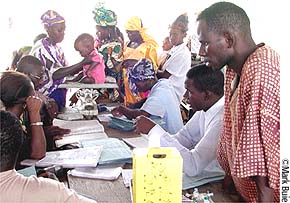 |
SPECIAL FEATURE - March 2002
En Français

Breathe in: a sick Iraqi girl with pneumonia is examined with a stethoscope |
This time, a vaccine for everyone?
With hopes running high for a new vaccine against the major killer pneumococcus, the Alliance partners are tackling the tough challenge of making sure it will be promptly available – and affordable – in developing countries. Phyllida Brown reports
FEW other microbes are as deadly. Pneumococcus kills at least 1 million people a year, according to WHO estimates – mainly young children in the world’s poorest countries. Most die of pneumonia, while some develop fatal meningitis or septicaemia. And even those who survive meningitis often suffer long-lasting disabilities.
Given its huge toll on life and health – equal to or greater than either malaria or measles – pneumococcus has managed to keep a relatively low profile in the public consciousness. But it may not do so for much longer. In 2002, this microbe is finally beginning to attract the concerted global attention required to tackle a major killer, for two reasons.
First, a new tool to protect children from the disease is within sight. A pneumococcal conjugate vaccine (see Box 1 ) is now on trial in South Africa and the Gambia, with the results of the first trials in South Africa due later this spring. Most researchers are hopeful. If the vaccine proves as effective as its close cousin, licensed two years ago in the United States, it could potentially save hundreds of thousands of children’s lives each year. "This could have a major impact on child survival, which is why GAVI has selected pneumococcal vaccines as a development priority," says Thomas Cherian, a paediatrician from the Christian Medical College, Vellore, India, who currently works at WHO’s Geneva headquarters coordinating global research activities on pneumococcal vaccines.
But a vaccine can only save lives if it is accessible – and this is the second reason why pneumococcus is coming under the spotlight now. 2002 sees the birth of an ambitious plan, probably the first of its kind in international health, to make sure that the vaccine will actually reach those who need it most within five years of its licensure.
Well aware that the field trials are not even finished, the key players – which include the Vaccine Fund and the manufacturers, governments and other key GAVI partners – are pressing ahead with the plan because if the vaccine works, there is no time to lose.

Mothers and babies in the Gambia, where a vaccine is on trial |
Breaking a vicious circle
Too often in the past, new vaccines developed against major diseases such as hepatitis B have waited 10 or even 20 years after their initial licensure to reach those in low-income countries where disease burden tends to be highest. “We have always got caught in a vicious circle,” says Orin Levine, a researcher at the National Institutes of Health in Bethesda, Maryland. Together with Jay Wenger and Thomas Cherian at WHO, Levine is charged by GAVI with the task of developing an agenda to rapidly evaluate and introduce pneumococcoal vaccines for developing countries. “Typically with new vaccines, the price is high,” says Levine, “so there is no demand from the low-income countries, and the industry has no incentive to invest in increased capacity and supply. We are trying to break that vicious circle, and we have to break it at multiple points.”
No one pretends that breaking that vicious circle will be easy. The price for pneumococcal conjugates is indeed high – at least relative to most children’s vaccines. The product licensed in the US, made by Wyeth Vaccines, is sold there at around $50 a dose, and with three doses required, it costs $150 to protect each child. The candidate vaccine now on trial in Africa is designed to protect against a wider range of serotypes, or strains, of pneumococcus than those found in the US; its price might be expected to be at least as high. But, while the era of vaccines costing just a few cents a dose is clearly over, few believe that a vaccine costing fully $150 per child will be attractive to developing countries, given that many of these countries’ governments spend under $20 on health per person each year. “This is a global issue,” says Keith Klugman, of Emory University, Atlanta, the principal investigator on the South Africa trial. “The price is clearly prohibitive.”
|
1: Pneumococcus: the disease
- The bacterium, properly known as Streptococcus pneumoniae, causes acute respiratory disease, ear infections, meningitis and septicaemia. Pneumonia is the biggest cause of death. Of those who develop meningitis, studies in the Gambia and elsewhere suggest half will die and most of the remainder suffer longterm disabilities (1) .
- Conservative estimates suggest that pneumococcus is responsible for at least 1 million of the 4 million deaths that occur worldwide each year in under-fives from acute respiratory infections (2) .
- Pneumococcal disease can be treated with antibiotics, but an increasing number of strains in circulation are antibiotic-resistant. Vaccines are the only effective way to control the disease and effective, globally available vaccines would be among the most useful tools in public health for decades.
- Although there are at least 90 known serotypes, or strains, of S. pneumoniae, 9-11 serotypes appear to account for up to 80% of disease cases, with the prevalence of different serotypes varying from region to region (3) .
Vaccines licensed and in trial
- Since February 2000 a pneumococcal conjugate vaccine made by Wyeth Vaccines has been licensed in the US and is routinely administered to infants there (4) . Seven pneumoccocal serotypes are conjugated to a protein carrier, a mutated nontoxic form of the diphtheria toxoid called CRM197; the vaccine is known as 7-valent. The conjugation technology – first developed for vaccines against Haemophilus influenzae type B (Hib) – is a feat in itself. For the pneumococcal vaccine, the bacterial polysaccharide from each different serotype is separately joined to a protein carrier in a laborious process.
- Unlike an earlier polysaccharide vaccine, the conjugate vaccine protects infants, the most vulnerable group. In trials, the vaccine reduced the incidence of invasive pneumococcal disease by more than 90 per cent, and also reduced pneumonia and ear infections.
- The vaccine on trial in Africa, also made by Wyeth, is 9-valent: in addition to the 7 original serotypes it includes two prevalent outside the US. If trials go well, a licence could be granted by about 2006. Additonal vaccines are at earlier stages ( Box 2 ).
- Early evidence suggests that children immunized against S. pneumoniae are not only protected themselves, but are also less likely to pass the infection on to others. So a vaccine may protect unvaccinated as well as vaccinated children in a population and may also reduce the spread of antibiotic-resistant strains (6) .
|
Putting real numbers on future demand
Wyeth appears willing to discuss a different price for the poorest countries, although no one is ready to start quoting figures at this stage. “The price is going to have to reach what is do-able and affordable,” says Peter Paradiso, vice-president for scientific affairs and research strategy at Wyeth’s Rochester, New York, base. “It is incumbent upon all of us to figure out how to do that, and to come up with a financial solution that can be acceptable to everybody”, he says.
But no manufacturer is going to invest in producing more vaccine unless it knows that it has a buyer. Vaccine companies need to know that there is a credible demand for their product, and gauge the size of that demand, before they will move ahead. “We need to have some hard numbers put into the system so that people can proceed,” says Paradiso. “The last thing we want is to build up capacity and have a vaccine that is unused.”
Which is where the new plan comes in. Sponsored by the World Bank, the Vaccine Fund and the Gates Foundation, the plan is an Alliance initiative to be agreed between public agencies, foundations, and vaccine manufacturers with products in development (See Box 2 ). It will set out a detailed road map for achieving the introduction of an agreed supply of an effective pneumococcal vaccine at an acceptable price, starting between 2006 and 2008.

Testing time: an enrolment session for the trial in The Gambia |
The plan, being drawn up with the help of management consultants McKinsey & Company, will set clear targets for each stage along the road, and identify key parties – such as the manufacturers, funding agencies and the technical teams that would implement the plan. All parties will be expected to make commitments at each stage. The idea sounds obvious, but such a plan is rare outside the private sector. “It’s common sense, as most really good ideas are,” says Amie Batson at the World Bank. “But it is a new departure for us.”
She hopes that the public sector can learn from the methods routinely employed by industry to plan the introduction of their products, and redirect those methods towards the global objective of achieving a speedy and equitable introduction of a pneumococcal vaccine. If the approach works, it might eventually be extended to other new vaccines in future.
The idea for a detailed plan evolved from an initial decision by the GAVI Board in November 2000 to make the development of pneumococcal vaccines a priority (5) , since when GAVI’s task forces for R&D and financing have been seeking advice and setting agendas for action. "We’re saying, let’s start with our end target – a given level of coverage with a pneumococcal vaccine – and work backwards to say what activities are needed, where, and when, to ensure that the target is met," says Batson.
|
2: A dwindling set of vaccine manufacturers
Wyeth’s 9-valent vaccine is the most advanced of the candidate pneumococcal conjugate vaccines. While many had hoped that, if trials proved successful, it could be licensed and used exactly as it is, the company favours developing the 9-valent vaccine as a combination product with meningococcus C.
Some researchers have argued against this combination, saying it would be inappropriate for developing countries as meningococcus C is a relatively minor pathogen in many populations, and the extra antigen is likely to add to the cost and even the time for bringing the product to market. Paradiso at Wyeth disputes this view and adds that, since the price of the vaccine in the poorest countries will be negotiated on different terms from those in industrialised countries, it will be unaffected by one extra antigen.
Regulatory problems
Although the rest of the field is not empty - quite - the alternatives are few. Glaxo SmithKline has developed an 11-valent candidate vaccine, but is currently reformulating it and doing additional work to improve the vaccine’s consistency, so its journey to market will be delayed.
Aventis Pasteur had developed an 11-valent pneumococcal candidate vaccine, currently undergoing field trials in the Philippines. However, the company has recently decided not to pursue commercialization of the vaccine.
Dr Juhani Eskola at Aventis Pasteur says the decision was taken because, although the vaccine produces a strong immune response when given at the same time as whole-cell DTP (DTwP) vaccine, it performs disappointingly when given at the same time as acellular DTP (DTaP). Since most industrialized countries use DTaP, this presents a serious problem for the company in gaining regulatory approval and marketing of the product.
"We asked ourselves whether we could develop the vaccine for the DTwP environment," says Dr Eskola. The final conclusion was no, since some further trials of the vaccine would also be required. "With these regulatory difficulties, the development time would be extended," he says. "Since we also have another pneumococcal candidate, a protein vaccine, in development that could be used with both DTaP and DTwP, we decided we would focus on that and try to get it to the market as quickly as possible." He says that the projected timelines for the extra work on the conjugate vaccine would be almost as long as for the new protein vaccine, so it was a logical choice to go for the newer approach. However, he says the new vaccine is at a relatively early stage, and it will be "several years" before development is complete, assuming of course that it proves protective in trials.
Too little competition
Some researchers are dismayed that Aventis Pasteur has abandoned a vaccine that could have been suitable for many developing countries in favour of a newer approach that is still some distance from market. "While there may be major practical advantages to the protein vaccine approach, it is unproven, whereas the conjugate is an established mechanism," says Kim Mulholland, a paediatrician specialising in international child health at the University of Melbourne.
Mulholland - and, privately, others - believe that Aventis Pasteur’s withdrawal of its product will also make it more difficult for the public sector to negotiate an affordable price for any pneumococcal vaccine in developing countries because Wyeth now has little competition. Eskola insists, however, that Aventis Pasteur remains "strongly committed" to work in the pneumococcus field and that the potential of the new vaccine is better. "Our plan really is to provide a vaccine for the whole world." |
Commitments by all parties
So far, the plan is just a framework to set out the details. "But by the end of 2002 we should have a good sense of the number of doses that might be needed, what the price range would be, and by what year," she says. By late 2003 proposals on funding should be drawn up, together with price and volume agreements with manufacturers. By 2004 the manufacturers should have clear agreements to scale up production and by 2006-2008, the vaccine could be purchased and introduced into a first group of countries. Preliminary discussions with the industry have already begun.
There are many intermediate steps to be taken before the ultimate goal can be reached. One example is to measure the burden of pneumococcal disease in different regions and countries. Governments are more likely to see the value of a vaccine if they know that it could prevent a significant number of deaths and cases of illness and disability in their population. So, to find out the true burden of the disease in each population, detailed epidemiological studies must be set up now, each of which must be financed from somebody’s budget. The plan will include details of exactly when such studies will be done and who will pay.
Can it work? Only if all sides – in public and private sectors – are prepared to think differently from before. Wyeth, for its part, is sounding cautiously positive. "The environment has changed," says Paradiso. "The Alliance is taking more ownership of this process."
Time for the public sector to take a risk
And, in the public sector too, there are some signs of a shift. "We [in the public sector] have to be willing to share the risks with the industry," says Levine. While industry has traditionally borne risks such as investing in production only to find that demand for a product is tiny or delayed for years, the public sector has generally been able to play safe with its money where vaccines are concerned. Some in the immunization community now think that, given the small number of manufacturers and the difficulties of guaranteeing markets in developing countries, that public-sector habit of playing safe may need to be rethought.
GAVI may need to commit itself, for instance, to buying a set number of doses of vaccine upfront – even, says Levine, if that means risking buying too much. "We have got to be prepared that someone will say, ’You spent millions on expensive vaccines that you cannot even use’," says Levine. Without willingess to take such risks, he believes, there might be no increase in the rate of progress and children in developing countries could still be waiting for pneumococcal vaccines in 2015.
High stakes
Does this mean that, to get vaccines to children in developing countries, the public sector has effectively to submit to the demands of the vaccine manufacturers? No, says Batson. "This process is in the public good and has to be controlled by the public sector. But it is in our interests to involve the private sector. The only way to accelerate access is for industry also to accelerate its investment in development and production capacity, so industry has to be involved." The stakes are high – and the responsibility on all players greater than ever before.
References
1. Goetghebuer T., et al. Outcome of meningitis caused by Streptococcus pneumoniae and Haemophilus influenzae type b in children in The Gambia. Trop Med Int Health. 2000 Mar;5 (3):207-13. (Medline: www.ncbi.nlm.nih.gov/entrez/query.fcgi )
2. Obaro SK., et al. Prospects for pneumococcal vaccination in African children. Acta Tropica 2000. 75 (2);141-53. (Medline: www.ncbi.nlm.nih.gov/entrez/query.fcgi )
3. Hausdorff WP., et al. Which pneumococcal serogroups cause the most invasive disease: implications for conjugate vaccine formulation and use, part I. Clin Infect Dis. 2000 Jan;30 (1):100-21. (Medline: www.ncbi.nlm.nih.gov/entrez/query.fcgi )
4. FDA press release February 2000. http://www.fda.gov/bbs/topics/NEWS/NEW00716.html
5. GAVI Product Agendas. www.vaccinealliance.org/reference/update_agendas.html
6. Klugman KP. et al . Efficacy of pneumococcal conjugate vaccines and their effect on carriage and antimicrobial resistance. Lancet Infect Dis 2001 Sep;1(2):85-91 and Obaro S., et al., The pneumococcus: carriage, disease and conjugate vaccines. J. Med. Microbiol 2002 Feb; 51 (2);98-104. (Medline: www.ncbi.nlm.nih.gov/entrez/query.fcgi )
Phyllida Brown
Immunization Focus March 2002 - Contents
 |
 |